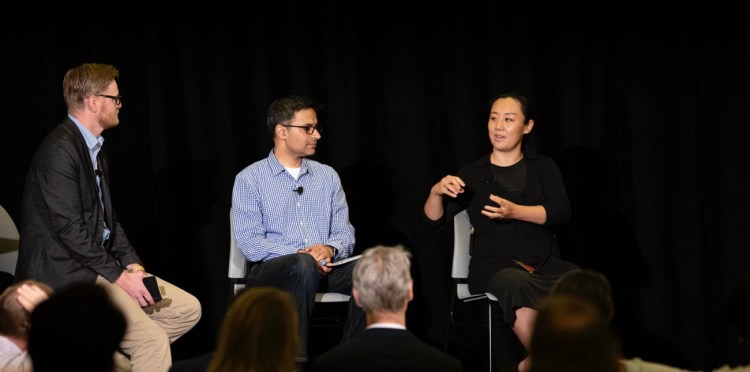The robotic process automation (RPA) industry has heated up over the last year with some of the leading players — like UiPath, Automation Anywhere, and Blue Prism — growing much faster than expected. At Transform 2019 this month, Guru Chahal, partner at Lightspeed Venture Partners, and Lan Xuezhao, founder and managing partner of Basis Set Ventures, attributed some of this excitement to a second wave of RPA capabilities.
“What we are seeing now is that the first generation of automation has played through,” Chahal said. Now RPA is starting to make it possible to automate things that were not feasible five to 10 years ago.
For example, machine learning makes it possible to interpret images and categorize them as part of a process. “Today there are some fundamental building blocks in computer vision, in NLP understanding, in overall machine learning and deep learning, and other pieces of technology that make a much larger pool of things automatable,” he said.
Three phases of RPA
These new kinds of AI capabilities are moving out of the labs and into production in a big way, and Chahal sees companies doubling down to automate more of their business. “The big change is that then it was theory; now the proof points are there. These companies aren’t just raising tons of money; they’re making tons of money.”
June 5th: The AI Audit in NYC
Join us next week in NYC to engage with top executive leaders, delving into strategies for auditing AI models to ensure fairness, optimal performance, and ethical compliance across diverse organizations. Secure your attendance for this exclusive invite-only event.
The first wave of RPA required process experts to understand what processes could be automated, as well as special coding skills to script the bots. This is currently where a lot of the RPA solutions are generating revenues today.
The next generation of RPA involves using automation to figure out what processes can be automated through better process discovery capabilities. For example, Lightspeed has invested in FortressIQ, which uses machine learning to interpret how employees interact with applications. This will make it easier for businesses to prioritize automations and could play a role in further accelerating the deployment of other RPA capabilities in the enterprise.
We’re at the beginning of this second phase, Chahal asserts, but a third phase is looming on the horizon. Both Chahal and Xuezhao assert that it will involve less human participation than ever.
Xuezhao drew a distinction between these early phases and the future third phase. “There are two ways we see companies grow,” she said, framing the former as more horizontal and the latter as primarily vertical.
In a vertically oriented third phase, “Instead of solving one problem, you actually build a robot that just solves literally bottom stack to the top stack — everything — and completely replaces humans,” she said. “[In] both dimensions, things are happening pretty fast, and iterating very rapidly.”
Chahal echoed her statement, adding that although people currently like what this generation of RPA can do mid-pipeline — humans deciding what to automate and automating it and then humans on the back end trying to figure out if it’s working well — there’s great potential value in automating the whole pipeline.
Beyond Silicon Valley
There’s a geographic element to this growth. That’s partly because RPA inherently affects legacy industries — like farming, mining, or manufacturing — that have processes ripe for automation. “The hunger today for absorbing technology in traditionally non-technical verticals is moreso than ever,” said Chahal.
Xuezhao said that although most of her company’s investments are still flowing through California, regions like the Midwest and South, as well as Canada, are also prevalent. “When we talk about factory automation, there’s not a lot of factory in California,” she noted. “When entrepreneurs want to start a company, they need to find clients, iterate, and build their products. Where are the natural places to go?” The Midwest, for example, is ideal. “We have a company in Ohio that does [a] welding robot. Ohio alone, for welding, is a 6 billion-dollar market.”
Both Xuezhao and Chahal spoke about other advantages of investing in companies outside of Silicon Valley, including price and talent, and the possibility of using distributed teams. “Talent is increasingly a global resource,” said Chahal. “We’ve always had this notion that we need to support entrepreneurs and businesses almost anywhere.”
The RPA market is expanding horizontally and vertically across all of North America, in all manner of legacy industries. In the long run, the increasing removal of humans from the process, with simultaneous horizontal and vertical growth, will likely lead to new kinds of RPA platforms.


